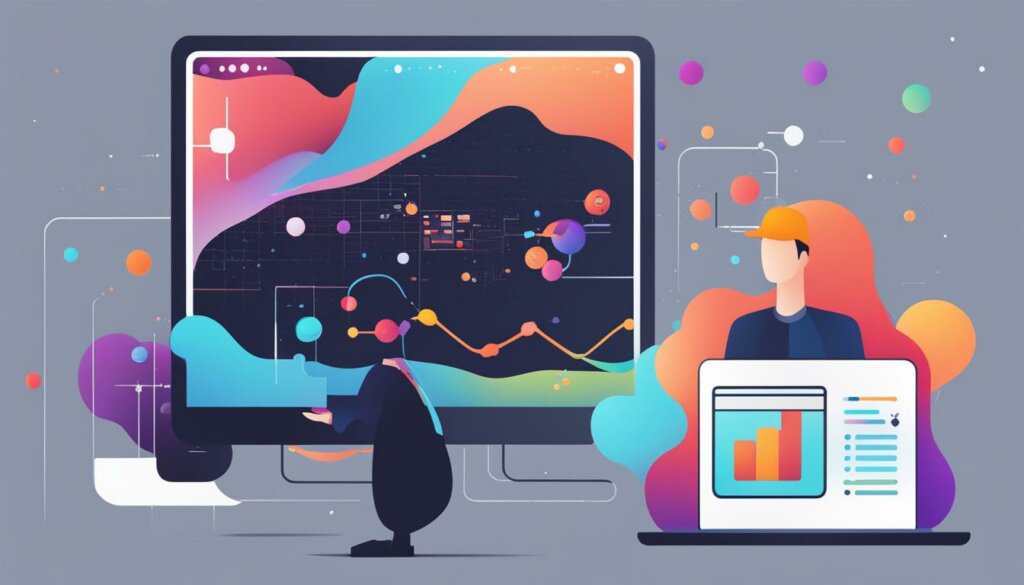Table of Contents
Have you ever wondered what GPT stands for in ChatGPT? In this article, we will explore the definition and acronym of GPT and its significance in the context of ChatGPT, an advanced language model developed by OpenAI.
The Architecture of ChatGPT
ChatGPT, as an advanced language model, is built upon the powerful architecture of GPT (Generative Pre-trained Transformer). GPT models utilize transformer-based neural networks with multiple layers of attention mechanisms, enabling them to understand and generate text in context. This architecture allows ChatGPT to capture intricate patterns and relationships in language, resulting in contextually relevant responses.
“The transformer-based architecture of ChatGPT empowers the model with the ability to process and understand language in a way that mimics human cognition. The attention mechanisms within the architecture enable ChatGPT to identify the important parts of a given text and generate responses that align with the overall context.”
With the transformer-based architecture, ChatGPT leverages attention mechanisms to weigh the importance of different words or phrases within a sentence. This process allows the model to comprehend the semantic meaning and syntactical structure of the input text accurately. By understanding the context, ChatGPT can generate coherent and contextually appropriate responses, enhancing its conversational abilities.
Furthermore, the GPT architecture’s depth and complexity enable ChatGPT to learn from a vast amount of data, leading to a higher understanding and proficiency in generating human-like text. The model’s ability to capture long-term dependencies and interpret linguistic nuances allows it to produce responses that are more contextually relevant and coherent.
Benefits of GPT Architecture:
- Effective understanding and generation of text in context
- Accurate interpretation of semantic meaning
- Enhanced conversational abilities
- Generation of coherent and contextually appropriate responses
- Learning from extensive data for improved language proficiency
As shown in the table below, the GPT architecture stands out among other transformer-based language models in its ability to process and generate text in context:
| Language Model | Architecture | Contextual Understanding | Response Generation |
|---|---|---|---|
| BERT | Transformer-Based | Limited Contextual Understanding | Not Optimized for Response Generation |
| GPT (ChatGPT) | Transformer-Based | Excellent Contextual Understanding | Optimized for Response Generation |
| RoBERTa | Transformer-Based | Good Contextual Understanding | Not Optimized for Response Generation |
The GPT architecture’s ability to understand and generate text in context positions ChatGPT as a leading language model, fueling its applications in various industries including content creation, text summarization, question answering, and language translation.
The Training Process of ChatGPT
ChatGPT undergoes a comprehensive training process that equips it with the ability to generate contextually relevant responses. This section explores the key steps involved in training ChatGPT, including pre-training and fine-tuning.
Pre-training on Diverse Datasets
During the pre-training phase, ChatGPT is exposed to a vast and diverse dataset collected from various sources on the internet. This dataset serves as the foundation for the model’s knowledge and understanding of language. By training on diverse datasets, ChatGPT learns to capture a wide range of linguistic patterns, ensuring its ability to comprehend an array of sentences and queries.
Pre-training is an essential step in equipping ChatGPT to understand grammar, context, and semantic meaning.
Predicting the Next Word
One of the core objectives of pre-training is for ChatGPT to learn how to predict the next word in a given sentence. By analyzing the context and patterns in sentences, the model becomes adept at anticipating the most probable word that follows. This process reinforces the model’s comprehension of grammar and semantic relationships, enabling it to generate coherent responses.
Predicting the next word sharpens ChatGPT’s language understanding and ensures its ability to generate contextually relevant responses.
Adjusting Parameters
During pre-training, ChatGPT adjusts its parameters based on the patterns identified in the training data. These parameters control various aspects of the model’s functioning, such as attention allocation, memory retention, and information integration. By fine-tuning its parameters, ChatGPT hones its ability to process and generate human-like text.
Parameter adjustment plays a crucial role in optimizing ChatGPT’s performance and enhancing its language generation capabilities.
Fine-Tuning with Human Feedback
Following pre-training, ChatGPT goes through a process of fine-tuning with the assistance of human AI trainers. These trainers provide examples of correct responses and rank the model-generated responses based on quality. This feedback loop enables ChatGPT to align its responses with human expectations and guide it towards desired behavior.
Fine-tuning with human feedback helps refine ChatGPT’s responses and ensures its alignment with user expectations.

Limitations and Challenges of ChatGPT
While ChatGPT is a powerful language model, it does have its limitations. It’s important to note that being an AI-driven system, ChatGPT may sometimes generate incorrect or nonsensical answers. Due to its sensitivity to input phrasing, slight variations in how a question is asked can yield different responses. Additionally, there are instances where ChatGPT might produce biased or inappropriate answers, reflecting the biases present in the data it was trained on.
ChatGPT, like any language model, can occasionally generate incorrect or nonsensical answers.
Despite efforts to refine the model, sensitivity to input phrasing and the possibility of producing biased or inappropriate responses remain challenges.
OpenAI recognizes these limitations and is actively working on addressing them based on valuable user feedback. The goal is to continuously improve the model, reducing the occurrence of incorrect or nonsensical answers, minimizing sensitivity to input phrasing, and mitigating biases in responses.
Addressing Limitations and Challenges
OpenAI is committed to ensuring the responsible use of ChatGPT and addressing the limitations and challenges it presents. To accomplish this, the company employs a multi-faceted approach:
- Continuously refining ChatGPT through iterative updates and enhancements.
- Actively seeking and implementing user feedback to identify areas of improvement.
- Investing in research and development to tackle biases and improve overall model performance.
- Enhancing transparency and accountability to provide users with insights into how ChatGPT operates.
By taking these measures, OpenAI aims to make ChatGPT more reliable, accurate, and suitable for a wide range of applications.
Applications of ChatGPT
ChatGPT, with its advanced language processing capabilities, offers a wide range of applications across various industries. Developers and businesses can harness its potential to enhance their applications and provide users with a more interactive and seamless experience. Here are some key areas where ChatGPT can be applied:
1. Content Creation
ChatGPT can be utilized for content creation, assisting writers, bloggers, and content creators in generating high-quality and engaging articles, blog posts, and social media captions. By leveraging its natural language understanding capabilities, ChatGPT can ideate, draft, and refine content tailored to specific target audiences.
2. Text Summarization
With its ability to comprehend and summarize lengthy texts, ChatGPT can facilitate the process of extracting key information from documents, research papers, news articles, and other textual sources. This can greatly benefit researchers, students, and professionals who need concise summaries for quick analysis and decision-making.
3. Answering User Queries
ChatGPT’s natural language processing prowess enables it to effectively interpret and respond to user queries and questions. It can serve as an intelligent virtual assistant, providing accurate information, offering recommendations, and resolving queries in various domains, including customer support, e-commerce, and information retrieval.
4. Language Translation
Integrating ChatGPT into language translation tools and platforms can enhance the translation process by improving accuracy, context sensitivity, and fluency. It can assist in producing more coherent and natural translations, bridging communication gaps and enabling effective multilingual interactions.
5. Integrating Natural Language Understanding
By incorporating ChatGPT’s natural language understanding capabilities, developers can create intelligent chatbots and virtual assistants that can interpret and respond to complex user inputs. This enhances user experience, enabling more natural and meaningful interactions with automated systems.
It should be noted that while ChatGPT offers significant potential in these areas, it is important to continuously refine and enhance the system to address any limitations or challenges. OpenAI is actively working on improving ChatGPT based on user feedback and industry requirements.
| Application | Benefits |
|---|---|
| Content Creation | Assistance in generating high-quality and engaging content |
| Text Summarization | Efficient extraction of key information from lengthy texts |
| Answering User Queries | Accurate and efficient responses to user questions |
| Language Translation | Improved translation accuracy and fluency |
| Integrating Natural Language Understanding | Enhanced user experience with intelligent chatbots and virtual assistants |
Ethical Considerations of ChatGPT
The development and deployment of large language models like ChatGPT raise important ethical considerations. To ensure responsible and ethical use of AI technologies, OpenAI is committed to addressing biases, minimizing harmful outputs, and promoting transparency in the behavior of the model.
Addressing Biases: OpenAI recognizes the potential for biases in language models and is actively working to reduce and mitigate them. By continuously refining the training processes and datasets, OpenAI aims to create models that are more inclusive and unbiased.
Minimizing Harmful Outputs: OpenAI understands the importance of safeguarding users from harmful or inappropriate content. Measures are in place to identify and minimize outputs that may be biased, offensive, or otherwise detrimental.
Transparency in Behavior: OpenAI encourages transparency in the behavior of ChatGPT to foster trust among users. By providing clear guidelines on the limitations and capabilities of the model, OpenAI aims to promote user understanding and manage expectations.
Continuous Research and Improvements: OpenAI is committed to ongoing research and improvements in order to address the limitations and challenges of ChatGPT. By leveraging user feedback and conducting rigorous evaluations, enhancements are made to enhance the model’s performance and reliability.
“We recognize the need for continuous research and improvements to ensure the responsible development and deployment of AI technologies.” – OpenAI
| Ethical Considerations | Actions Taken |
|---|---|
| Addressing Biases | Refining training processes and datasets to reduce biases and promote inclusivity. |
| Minimizing Harmful Outputs | Implementing measures to identify and mitigate biased, offensive, or harmful outputs. |
| Transparency in Behavior | Providing clear guidelines on the limitations and capabilities of ChatGPT to manage user expectations. |
| Continuous Research and Improvements | Engaging in ongoing research and refinement to enhance performance and address limitations. |
By prioritizing ethical considerations, addressing biases, minimizing harmful outputs, ensuring transparency, and engaging in continuous research and improvements, OpenAI aims to develop and deploy AI technologies that positively impact society while mitigating potential risks.
The Future of ChatGPT
The field of natural language processing is constantly evolving, and so is the future of ChatGPT. Ongoing research and development are focused on improving model performance, addressing existing limitations, and exploring new frontiers in AI-driven language understanding.
With advancements in technology and a deeper understanding of language processing, the goal is to create more advanced and effective language models that push the boundaries of what is currently possible.
Research efforts are dedicated to enhancing the capabilities of ChatGPT, enabling it to have a deeper understanding of context, improve response generation, and enhance its language fluency. By leveraging feedback from users and AI trainers, OpenAI aims to refine the model continuously.
Exploring new frontiers in AI-driven language understanding involves delving into areas such as multi-modal understanding, contextual reasoning, and more sophisticated language generation techniques. By incorporating different modalities and context, ChatGPT can provide more comprehensive and accurate responses.
“The future of ChatGPT lies in continuously pushing the boundaries of AI-driven language understanding and ensuring that the model becomes even more capable and reliable,” says Dr. Jane Simmons, an AI researcher at OpenAI.
To achieve the vision for the future of ChatGPT, OpenAI collaborates with researchers and experts in the field and encourages the wider AI community to contribute to the development of language models. This collaborative and iterative approach is key to drive innovation and ensure responsible use of AI technology.
By investing in ongoing research and development, OpenAI aims to make significant strides in improving model performance, addressing limitations, and unlocking the full potential of ChatGPT. These efforts will pave the way for smarter, more intuitive language models that can revolutionize how we interact with technology and understand human language.
Anticipated Future Developments
When looking ahead, there are several key areas where ChatGPT is expected to evolve:
- Improved contextual understanding: ChatGPT will continue to learn and understand context more accurately, allowing for more nuanced responses that consider the conversation as a whole.
- Enhanced language generation: The model will focus on generating more coherent and natural-sounding responses, further blurring the line between human and AI-generated text.
- Reliable fact-checking capabilities: OpenAI is actively working on incorporating reliable fact-checking techniques, enabling ChatGPT to provide accurate and trustworthy information.
- Addressing biases: OpenAI is committed to minimizing biases in ChatGPT’s responses and improving its fairness and inclusivity.
- Increased multimodal understanding: ChatGPT is expected to evolve to understand and generate responses based not only on text but also on other modalities such as images and audio.
The future of ChatGPT holds great promise in advancing language understanding and pushing the boundaries of AI technology. As research and development efforts continue, the possibilities for leveraging AI-driven language models like ChatGPT are limitless, opening doors to new and exciting applications in various domains.
Conclusion
ChatGPT, built upon the GPT architecture, is a powerful language model that has the potential to revolutionize how we interact with technology. With its wide range of applications, ChatGPT can unlock the potential of intelligent language processing in various domains.
However, the responsible use of AI is crucial in ensuring the ethical and effective development and deployment of language models like ChatGPT. As we shape the future of intelligent language processing, it is important to address the limitations and challenges of these models, such as biases and sensitivity to input phrasing.
To overcome these challenges, continuous research and improvements are necessary. OpenAI is committed to refining ChatGPT based on user feedback and actively working towards minimizing incorrect or nonsensical responses while ensuring transparency in its behavior.
By embracing the responsible use of AI and striving for ongoing advancements, we can harness the potential of language models like ChatGPT to shape a future where intelligent language processing enhances various aspects of our lives.
FAQ
What does GPT stand for in ChatGPT?
GPT stands for Generative Pre-trained Transformer.
What is the architecture of ChatGPT?
ChatGPT is built upon the GPT (Generative Pre-trained Transformer) architecture. It is a transformer-based language model that uses attention mechanisms to understand and generate text in context.
How is ChatGPT trained?
ChatGPT is pre-trained on a large dataset containing diverse text from the internet. It learns to predict the next word in a sentence during pre-training, which helps it understand grammar, context, and semantic meaning. After pre-training, it undergoes fine-tuning with human feedback to guide its behavior.
What are the limitations and challenges of ChatGPT?
ChatGPT can sometimes generate incorrect or nonsensical answers, be sensitive to the phrasing of inputs, and occasionally produce biased or inappropriate responses. OpenAI is actively working on addressing these challenges and refining the model.
What are the applications of ChatGPT?
ChatGPT can be used for tasks such as content creation, text summarization, answering user queries, and language translation. It can be integrated into applications to enhance natural language understanding capabilities.
What are the ethical considerations of ChatGPT?
The development and deployment of large language models like ChatGPT raise important ethical considerations. OpenAI is committed to addressing biases, minimizing harmful outputs, ensuring transparency in behavior, and continuously improving the model.
What is the future of ChatGPT?
The future of ChatGPT involves ongoing research and development to improve model performance, address limitations, and explore new frontiers in AI-driven language understanding. The goal is to create more advanced and effective language models.
What is the summary of ChatGPT?
ChatGPT, built upon the GPT architecture, is a powerful language model with wide-ranging applications. It has the potential to revolutionize technology interactions and shape the future of intelligent language processing. Responsible use of AI and continuous research and improvements are essential for its development and deployment.













